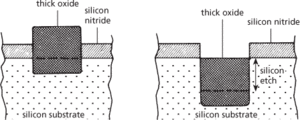A technique used during the manufacture of LSI MOS integrated circuits and some forms of LSI bipolar integrated circuits, such as I2L. Regions of relatively thick silicon dioxide are used in order to isolate device areas. The coplanar process was developed in order to minimize the vertical projection of the oxide layer. A layer of silicon nitride is deposited on the surface of the silicon wafer and is etched to expose the regions of the surface where thick oxide is required. As oxidation takes place, the effective silicon surface moves downwards and is replaced by a thicker layer of silicon dioxide, so that approximately one third of the oxide is below the original exposed surface level (Fig. a). Oxidation may be preceded by etching of the exposed silicon surface so that the final oxide surface is at the same level as the original substrate (Fig. b). The silicon nitride is then removed from the rest of the surface and the integrated circuits are formed using normal planar-process technology.

(a) Coplanar process with nitride etch (b) Nitride plus silicon etch
- localism
- locality
- localization
- localization economies
- localized bond
- localized states
- localizer beacon
- local knowledge
- local loop
- locally compact
- local maximum
- local mean time
- local multipoint distribution system
- local optimization
- local oscillator
- local public good
- local range zone
- local realism
- local sidereal time
- local standard of rest
- local supercluster
- local thermodynamic equilibrium
- local time
- local wind
- local winds